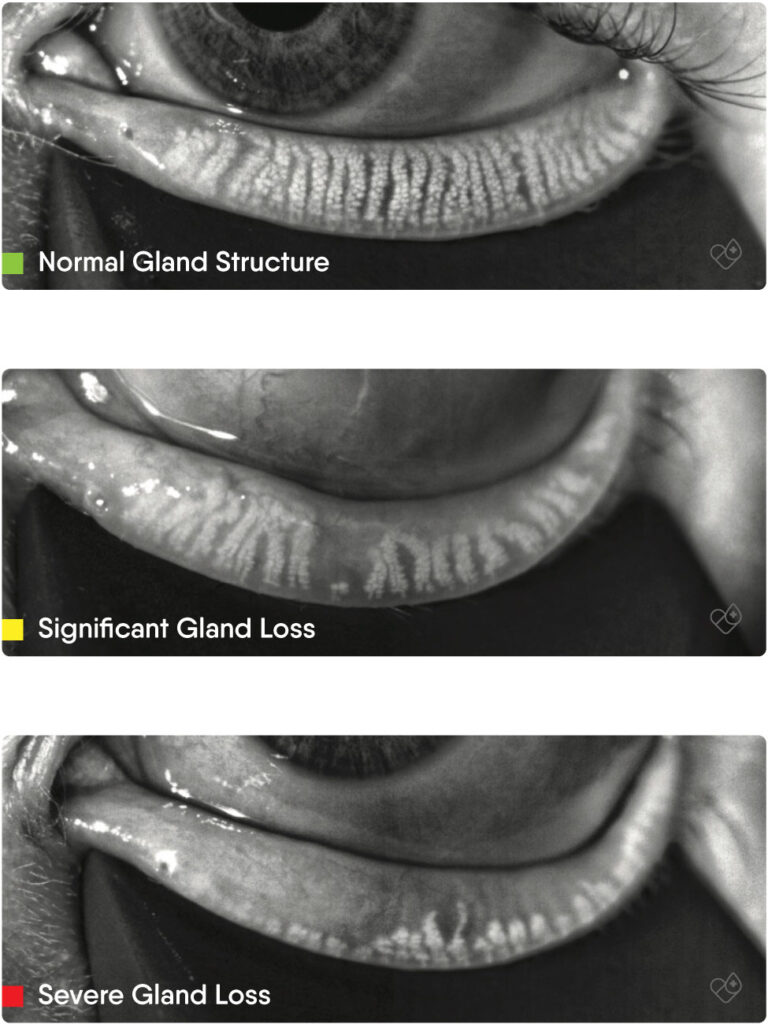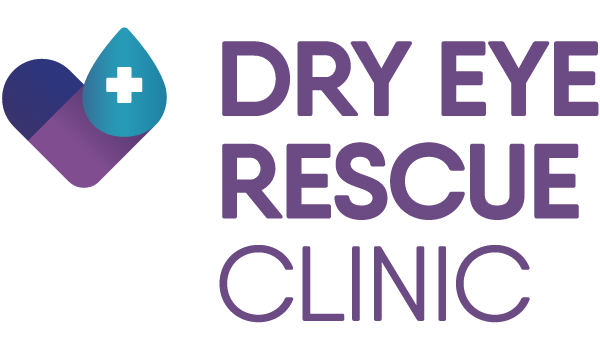Dry Eye Conditions
- Blepharitis
- Dry Eye Disease
- MGD
So, what is Dry Eye?
Dry eye is a condition where your eyes don’t make enough tears — or the right kind of tears — to stay properly lubricated. That might sound simple, but tears are more complex than just water. They’re made up of three key layers: oil, water, and mucus. If any part of this system is out of balance, your eyes can become dry, irritated, and uncomfortable.
It’s one of the most common eye complaints, yet many people don’t realize they have it. Dry eye can show up as:
- Stinging, burning, or scratchy eyes
- Redness or blurry vision
- A feeling like something is in your eye
- Eye fatigue, especially during screen time
- Watery eyes (yes, it can actually be a sign of dry eye!)
Dry eye doesn’t come from one single issue — it’s usually a combination of problems involving your eyelids, glands, environment, and even how often you blink. Some of the most common causes include:
- Blocked oil glands (Meibomian Gland Dysfunction)
- Inflammation on the surface of the eye
- Eyelid issues like blepharitis
- Aging, hormones, or medications
- Too much screen time (which reduces your blink rate)
Understanding which type you have helps guide the right treatment:
1. Aqueous Deficient Dry Eye
This happens when your eyes don’t produce enough of the watery layer of your tears. It’s less common, but often more severe.
2. Evaporative Dry Eye
This is the most common type. Your eyes make enough tears, but they evaporate too quickly — often due to poor oil quality from blocked meibomian glands (MGD).
Most people start with artificial tears from the drugstore — and while those can help temporarily, they don’t treat the root cause. At Dry Eye Rescue Clinic, we use advanced diagnostics to pinpoint what’s really causing your symptoms, then build a personalized care plan that may include:
In-office treatments like LipiFlow®, IPL, or RF therapy
BlephEx® lid cleaning for blepharitis
Prescription or over-the-counter eye drops
Home care tips for eyelid hygiene, blinking, and hydration
Blepharitis
There are two main types of blepharitis:
- Anterior Blepharitis: Affects the outside of the eyelid where the eyelashes grow. Often linked to bacteria, seborrheic dermatitis, or the presence of Demodex mites.
- Posterior Blepharitis: Occurs along the inner lid margin and is often tied to meibomian gland dysfunction (MGD), where oil glands become blocked or inflamed.
Left untreated, blepharitis can disrupt the tear film and contribute to chronic dry eye symptoms. At Dry Eye Rescue Clinic, we offer in-office treatments like BlephEx®, which gently exfoliates the lid margins to remove debris and reduce inflammation. This non-invasive treatment helps restore eyelid health and improve daily comfort.
Dry Eye Disease
Dry Eye Disease is more than just occasional dryness — it’s a chronic condition that occurs when your eyes don’t produce enough tears or when the tears evaporate too quickly. This can lead to a range of symptoms, including:
- Persistent dryness or burning
- Red, irritated eyes
- Blurred or fluctuating vision
- Light sensitivity
- A sensation of something in the eye
- Difficulty with screen time or reading
For many patients, these symptoms are linked to underlying causes like inflammation, poor tear quality, or gland dysfunction.
At Dry Eye Rescue Clinic, we use advanced diagnostic tools to uncover what’s really driving your dry eye symptoms. Whether it’s inflammation, meibomian gland blockage, or eyelid conditions like blepharitis, our goal is to identify the root cause and create a treatment plan designed specifically for you.
Meibomian Gland Dysfunction (MGD)
MGD is one of the most common — and often overlooked — causes of dry eye. The meibomian glands, located in your eyelids, are responsible for releasing oils that prevent tears from evaporating too quickly. When these glands become blocked or stop working properly, the tear film becomes unstable, leading to irritation and dryness.
Common signs of MGD include:
- Burning or stinging eyes
- Blurred vision that improves with blinking
- Eyelid heaviness
- Eye fatigue
- Fluctuating comfort while wearing contact lenses
MGD often requires more than just artificial tears. At Dry Eye Rescue Clinic, we offer treatments like LipiFlow®, OptiPLUS RF, and manual expression therapies to help restore healthy gland function and improve tear quality over time.

The Blink–Dry Eye Connection
Here’s something most people don’t know: blinking plays a critical role in preventing dry eyes. Every time you blink, your eyelids spread a thin, even layer of tears across your eye — keeping it hydrated, protected, and clear.
But if you’re spending long hours on a screen or phone, your blink rate can drop by more than 50%. That means your eyes aren’t getting the tear coverage they need, which leads to faster evaporation and more dryness.
At Dry Eye Rescue Clinic, we evaluate your blink patterns as part of your exam and offer therapies to improve blink quality — helping your eyes stay healthy with every blink.
Every Journey Starts with the Right Evaluation
At Dry Eye Rescue Clinic, every patient begins with a comprehensive Dry Eye Evaluation — the most important step toward lasting relief.
Using advanced diagnostic technology and the expertise of our dry eye specialists, we identify the exact cause of your symptoms. Whether it’s inflammation, blocked glands, poor tear quality, or a combination of factors, our evaluation process is designed to uncover the root problem so we can build the right treatment plan for you.
The best part? Most evaluations are covered by insurance.
Schedule your evaluation today and start your journey toward healthier eyes.
Common Dry Eye Conditions
Blepharitis is a common condition that causes inflammation along the edges of the eyelids. It can lead to red, irritated eyes, crusting at the lash line, and chronic discomfort. Some patients describe it as having a constant gritty or itchy sensation in their eyes, especially in the morning.
There are two main types of blepharitis:
- Anterior Blepharitis: Affects the outside of the eyelid where the eyelashes grow. Often linked to bacteria, seborrheic dermatitis, or the presence of Demodex mites.
- Posterior Blepharitis: Occurs along the inner lid margin and is often tied to meibomian gland dysfunction (MGD), where oil glands become blocked or inflamed.
Left untreated, blepharitis can disrupt the tear film and contribute to chronic dry eye symptoms. At Dry Eye Rescue Clinic, we offer in-office treatments like BlephEx®, which gently exfoliates the lid margins to remove debris and reduce inflammation. This non-invasive treatment helps restore eyelid health and improve daily comfort.
Understanding which type you have helps guide the right treatment:
1. Aqueous Deficient Dry Eye
This happens when your eyes don’t produce enough of the watery layer of your tears. It’s less common, but often more severe.
2. Evaporative Dry Eye
This is the most common type. Your eyes make enough tears, but they evaporate too quickly — often due to poor oil quality from blocked meibomian glands (MGD).
Most people start with artificial tears from the drugstore — and while those can help temporarily, they don’t treat the root cause. At Dry Eye Rescue Clinic, we use advanced diagnostics to pinpoint what’s really causing your symptoms, then build a personalized care plan that may include:
In-office treatments like LipiFlow®, IPL, or RF therapy
BlephEx® lid cleaning for blepharitis
Prescription or over-the-counter eye drops
Home care tips for eyelid hygiene, blinking, and hydration
